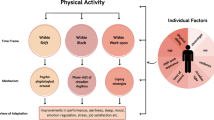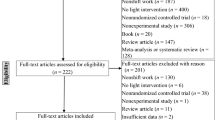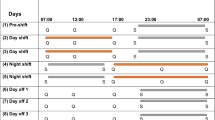Abstract
The objective of the study was to perform a literature review on the health consequences of working rotating shifts and implications for structural design. A literature search was performed in June 2012 and a selection of the most relevant peer-review articles was included in the present review. Shift workers are more likely to suffer from a circadian sleep disorder characterized by sleepiness and insomnia. Shift work is associated with decreased productivity, impaired safety, diminished quality of life and adverse effects on health. Circadian disruption resulting from rotating shift work has also been associated with increased risk for metabolic syndrome, diabetes, cardiovascular disease and cancer. This article summarizes the known health effects of shift work and discusses how light can be used as a countermeasure to minimize circadian disruption at night while maintaining alertness. In the context of the lighted environment, implications for the design of newborn intensive care units are also discussed.
This is a preview of subscription content, access via your institution
Access options
Subscribe to this journal
Receive 12 print issues and online access
$259.00 per year
only $21.58 per issue
Buy this article
- Purchase on Springer Link
- Instant access to full article PDF
Prices may be subject to local taxes which are calculated during checkout


Similar content being viewed by others
References
Beers TM . Flexible schedules and shift work: replacing the '9-to-5' workday? Mthly Labor Rev (Bureau of Labor Statistics) 2000; 123: 6.
Moore RY . Circadian rhythms: basic neurobiology and clinical applications. Annu Rev Med 1997; 48: 253–266.
Rea M, Figueiro M, Bullough J . Circadian photobiology: an emerging framework for lighting practice and research. Light Res Technol 2002; 34: 177–190.
Berson D, Dunn F, Takao M . Phototransduction by retinal ganglion cells that set the circadian clock. Science 2002; 295: 1070–1073.
Brainard GC, Hanifin JP, Greeson JM, Byrne B, Glickman G, Gerner E et al. Action spectrum for melatonin regulation in humans: evidence for a novel circadian photoreceptor. J Neurosci 2001; 21: 6405–6412.
Thapan K, Arendt J, Skene DJ . An action spectrum for melatonin suppression: evidence for a novel non-rod, non-cone photoreceptor system in humans. J Physiol 2001; 535: 261–267.
Rea MS, Figueiro MG, Bullough JD, Bierman A . A model of phototransduction by the human circadian system. Brain Res Rev 2005; 50: 213–228.
Jewett M, Rimmer D, Duffy J, Klerman E, Kronauer R, Czeisler C . Human circadian pacemaker is sensitive to light throughout subjective day without evidence of transients. Am J Physiol 1997; 273: R1800–R1809.
Khalsa SB, Jewett ME, Cajochen C, Czeisler CA . A phase response curve to single bright light pulses in human subjects. J Physiol 2003; 549: 945–952.
Glickman G, Hanifin J, Rollag M, Wang J, Cooper H, Brainard G . Inferior retinal light exposure is more effective than superior retinal exposure in suppressing melatonin in humans. J Biol Rhythms 2003; 18: 71–79.
Hebert M, Martin SK, Lee C, Eastman CI . The effects of prior light history on the suppression of melatonin by light in humans. J Pineal Res 2002; 33: 198–203.
Chang AM, Scheer FA, Czeisler CA . The human circadian system adapts to prior photic history. J Physiol 2011; 589: 1095–1102.
Straif K, Baan R, Grosse Y, Secretan B, Ghissassi FE, Bouvard V et al. Carcinogenicity of shift-work, painting, and fire-fighting (on behalf of the WHO International Agency for Research on Cancer Monograph Working Group). Lancet Oncol 2007; 8: 1065–1066.
Arendt J . Melatonin and the Mammalian Pineal Gland 1st edn Chapman & Hall: London, 1995.
Carrillo-Vico A, Guerrero JM, Lardone PJ, Reiter RJ . A review of the multiple actions of melatonin on the immune system. Endocrine 2005; 27: 189–200.
Erren TC, Reiter RJ, Piekarski C . Light, timing of biological rhythms, and chronodisruption in man. Naturwissenschaften 2003; 90: 485–494.
Chen LJ, Gao YQ, Li XJ, Shen DH, Sun FY . Melatonin protects against MPTP/MPP+ -induced mitochondrial DNA oxidative damage in vivo and in vitro. J Pineal Res 2005; 39: 34–42.
Panzer A, Lottering ML, Bianchi P, Glencross DK, Stark JH, Seegers JC . Melatonin has no effect on the growth, morphology or cell cycle of human breast cancer (MCF-7), cervical cancer (HeLa), osteosarcoma (MG-63) or lymphoblastoid (TK6) cells. Cancer Lett 1998; 122: 17–23.
Hill SM, Blask DE . Effects of the pineal hormone melatonin on the proliferation and morphological characteristics of human breast cancer cells (MCF-7) in culture. Cancer Res 1988; 48: 6121–6126.
Cos S, Fernandez F, Sanchez-Barcelo EJ . Melatonin inhibits DNA synthesis in MCF-7 human breast cancer cells in vitro. Life Sci 1996; 58: 2447–2453.
Cos S, Fernandez R, Guezmes A, Sanchez-Barcelo EJ . Influence of melatonin on invasive and metastatic properties of MCF-7 human breast cancer cells. Cancer Res 1998; 58: 4383–4390.
Mediavilla MD, Cos S, Sanchez-Barcelo EJ . Melatonin increases p53 and p21WAF1 expression in MCF-7 human breast cancer cells in vitro. Life Sci 1999; 65: 415–420.
Cos S, Mediavilla MD, Fernandez R, Gonzalez-Lamuno D, Sanchez-Barcelo EJ . Does melatonin induce apoptosis in MCF-7 human breast cancer cells in vitro? J Pineal Res 2002; 32: 90–96.
Ying SW, Niles LP, Crocker C . Human malignant melanoma cells express high-affinity receptors for melatonin: antiproliferative effects of melatonin and 6-chloromelatonin. Eur J Pharmacol 1993; 246: 89–96.
Sze SF, Ng TB, Liu WK . Antiproliferative effect of pineal indoles on cultured tumor cell lines. J Pineal Res 1993; 14: 27–33.
Shiu SY, Li L, Xu JN, Pang CS, Wong JT, Pang SF . Melatonin-induced inhibition of proliferation and G1/S cell cycle transition delay of human choriocarcinoma JAr cells: possible involvement of MT2 (MEL1B) receptor. J Pineal Res 1999; 27: 183–192.
Petranka J, Baldwin W, Biermann J, Jayadev S, Barrett JC, Murphy E . The oncostatic action of melatonin in an ovarian carcinoma cell line. J Pineal Res 1999; 26: 129–136.
Kanishi Y, Kobayashi Y, Noda S, Ishizuka B, Saito K . Differential growth inhibitory effect of melatonin on two endometrial cancer cell lines. J Pineal Res 2000; 28: 227–233.
Blask DE, Brainard GC, Dauchy RT, Hanifin JP, Davidson LK, Krause JA et al. Melatonin-depleted blood from premenopausal women exposed to light at night stimulates growth of human breast cancer xenografts in nude rats. Cancer Res 2005; 65: 11174–11184.
Reiter RJ . Mechanisms of cancer inhibition by melatonin. J Pineal Res 2004; 37: 213–214.
Haus E, Smolensky M . Biological clocks and shift work: circadian dysregulation and potential long-term effects. Cancer Causes Control 2006; 17: 489–500.
Haus E . Chronobiology of the mammalian response to ionizing radiation. Potential applications in oncology. Chronobiol Int 2002; 19: 77–100.
Filipski E, King VM, Li X, Granda TG, Mormont M-C, Liu X et al. Host circadian clock as a control point in tumor progression. J Natl Cancer Inst 2002; 94: 690–697.
Filipski E, King VM, Li X, Granda TG, Mormont M-C, Claustrat B et al. Disruption of circadian coordination accelerates malignant growth in mice. Pathol Biol 2003; 51: 216–219.
Schernhammer ES, Hankinson SE . Urinary melatonin levels and breast cancer risk. J Natl Cancer Inst 2005; 97: 1084–1087.
Fu L, Lee CC . The circadian clock: pacemaker and tumour suppressor. Nat Rev Cancer 2003; 3: 350–361.
You S, Wood PA, Xiong Y, Kobayashi M, Du-Quiton J, Hrushesky WJM . Daily coordination of cancer growth and circadian clock gene expression. Breast Cancer Res Treat 2005; 91: 47–60.
Metz RP, Qu X, Laffin B, Earnest D, Porter WW . Circadian clock and cell cycle gene expression in mouse mammary epithelial cells and in the developing mouse mammary gland. Dev Dyn 2006; 235: 263–271.
Pukkala E, Auvinen H, Wahlberg G . Incidence of cancer among Finnish airline cabin attendants. BMJ 1995; 311: 649–652.
Rafnsson V, Tulinius H, Jonasson JG, Hrafnkelsson J . Risk of breast cancer in female flight attendants: a population-based study (Iceland). Cancer Causes Control 2001; 12: 95–101.
Tynes T, Hannevik M, Andersen A, Vistnes AI, Haldorsen T . Incidence of breast cancer in Norwegian female radio and telegraph operators. Cancer Causes Control 1996; 7: 197–204.
Hansen J . Increased breast cancer risk among women who work predominantly at night. Epidemiology 2001; 12: 74–77.
Davis S, Mirick DK, Stevens RG . Night shift work, light at night, and risk of breast cancer. J Natl Cancer Inst 2001; 93: 1557–1562.
Schernhammer ES, Laden F, Speizer FE, Willet WC, Hunter DJ, Kawahi I et al. Rotating night shifts and risk of breast cancer in women participating in the Nurses’ Health Study. J Natl Cancer Inst 2001; 93: 1563–1568.
Megdal SP, Kroenke CH, Laden F, Pukkala E, Schernhammer ES . Night work and breast cancer risk: a systematic review and meta-analysis. Eur J Cancer 2005; 41: 2023–2032.
Hansen J, Stevens RG . Night shiftwork and breast cancer risk: overall evidence. Occup Environ Med 2011; 68: 236.
Lie J-AS, Kjuus H, Zienolddiny S, Haugen A, Stevens RG, Kjærheim K . Night work and breast cancer risk among Norwegian nurses: assessment by different exposure metrics. Am J Epidemiol 2011; 173: 1272–1279.
Pesch B, Harth V, Rabstein S, Baisch C, Schiffermann M, Pallapies D et al. Night work and breast cancer—results from the German GENICA study. Scand J Work Environ Health 2010; 36: 134–141.
Pronk A, Ji B-T, Shu X-O, Xue S, Yang G, Li H-L et al. Night-shift work and breast cancer risk in a cohort of Chinese women. Am J Epidemiol 2010; 171: 953–959.
Farriol M, Venereo Y, Orta X, Castellanos JM, Segovia-Silvestre T . In vitro effects of melatonin on cell proliferation in a colon adenocarcinoma line. J Appl Toxicol 2000; 20: 21–24.
Anisimov VN, Popovich IG, Zabezhinski MA . Melatonin and colon carcinogenesis: I. Inhibitory effect of melatonin on development of intestinal tumors induced by 1,2-dimethylhydrazine in rats. Carcinogenesis 1997; 18: 1549–1553.
Anisimov VN, Kvetnoy IM, Chumakova NK, Kvetnaya TV, Molotkov AO, Pogudina NA et al. Melatonin and colon carcinogenesis. Exp Toxicol Pathol 1999; 51: 47–52.
Anisimov VN, Kvetnoy IM, Chumakova NK, Kvetnaya TV, Molotkov AO, Pogudina NA et al. Melatonin and colon carcinogenesis. III. Effect of melatonin on proliferative activity and apoptosis in colon mucosa and colon tumors induced by 1,2-dimethylhydrazine in rats. Exp Toxic Pathol 2000; 52: 71–76.
Rafnsson V, Gunnarsdottir H . Mortality study of fertiliser manufacturers in Iceland. Br J Ind Med 1990; 47: 721–725.
Taylor PJ, Pocock SJ . Mortality of shift and day workers 1956-68. Br J Ind Med 1972; 29: 201–207.
Grundy A, Tranmer J, Richardson H, Graham CH, Aronson KJ . The influence of light at night exposure on melatonin levels among Canadian rotating shift nurses. Cancer Epidemiol Biomarkers Prev 2011; 20: 2404–2412.
Peplonska B, Bukowska A, Gromadzinska J, Sobala W, Reszka E, Lie J-A et al. Night shift work characteristics and 6-sulfatoxymelatonin (MT6s) in rotating night shift nurses and midwives. Occup Environ Med 2012; 69: 339–346.
Langley AR, Graham CH, Grundy AL, Tranmer JE, Richardson H, Aronson KJ . A cross-sectional study of breast cancer biomarkers among shift working nurses. BMJ Open 2012; 2: e000532.
Schernhammer ES, Kroenke CH, Laden F, Hankinson SE . Night work and risk of breast cancer. Epidemiology 2006; 17: 108–111.
Dumont M, Lanctôt V, Cadieux-Viau R, Paquet J . Melatonin production and light exposure of rotating night workers. Chronobiol Int 2012; 29: 203–210.
Viitasalo K, Lindström J, Hemiö K, Puttonen S, Koho A, Härmä M et al. Occupational health care identifies risk for type 2 diabetes and cardiovascular disease. Prim Care Diabetes 2012; 6: 95–102.
Brown DL, Feskanich D, Sánchez BN, Rexrode KM, Schernhammer ES, Lisabeth LD . Rotating night shift work and the risk of ischemic stroke. Am J Epidemiol 2009; 169: 1370–1377.
Drake CL, Roehrs T, Richardson G, Walsh JK, Roth T . Shift work sleep disorder: prevalence and consequences beyond that of symptomatic day workers. Sleep 2004; 27: 1453–1462.
Pan A, Schernhammer ES, Sun Q, Hu FB . Rotating night shift work and risk of type 2 diabetes: two prospective cohort studies in women. PLoS Med 2011; 8: e1001141.
Antunes LC, Levandovski R, Dantas G, Caumo W, Hidalgo MP . Obesity and shift work: chronobiological aspects. Nutr Res Rev 2010; 23: 155–168.
Knutsson A, Bøggild H . Gastrointestinal disorders among shift workers. Scand J Work Environ Health 2010; 36: 85–95.
Lawson CC, Rocheleau CM, Whelan EA, Lividoti Hibert EN, Grajewski B, Spiegelman D et al. Occupational exposures among nurses and risk of spontaneous abortion. Am J Obstet Gynecol 2012; 206: 327 e1–8.
Mahoney MM . Shift work, jet lag, and female reproduction. Int J Endocrinol 2010; 2010: 813764.
Badia P, Myers B, Boeckner M, Culpepper J, Harsh JR . Bright light effects on body temperature, alertness, EEG and behavior. Physiol Behav 1991; 50: 583–588.
Cajochen C, Zeitzer JM, Czeisler CA, Dijk DJ . Dose-response relationship for light intensity and ocular and electroencephalographic correlates of human alertness. Behav Brain Res 2000; 115: 75–83.
Cajochen C, Munch M, Kobialka S, Krauchi K, Steiner R, Oelhafen P et al. High sensitivity of human melatonin, alertness, thermoregulation and heart rate to short wavelength light. J Clin Endocrinol Metab 2005; 90: 1311–1316.
Figueiro MG, Rea MS, Boyce P, White R, Kolberg K . The effects of bright light on day and night shift nurses’ performance and well-being in the NICU. Neonatal Intens Care 2001; 14: 29–32.
Smith MR, Fogg LF, Eastman CI . A compromise circadian phase position for permanent night work improves mood, fatigue, and performance. Sleep 2009; 32: 1481–1489.
Figueiro MG, Bullough JD, Bierman A, Fay CR, Rea MS . On light as an alerting stimulus at night. Acta Neurobiol Exp (Wars) 2007; 67: 171–178.
Figueiro MG, Bierman A, Plitnick B, Rea MS . Preliminary evidence that both blue and red light can induce alertness at night. BMC Neurosci 2009; 10: 105.
Figuero MG, Rea MS . The effects of red and blue lights on circadian variations in cortisol, alpha amylase and melatonin. Int J Endocrinol 2010; 2010: 829351.
Phipps-Nelson J, Redman JR, Bijk DJ, Rajaratnam SM . Daytime exposure to bright light, as compared to dim light, decreases sleepiness and improves psychomotor vigilance performance. Sleep 2003; 26: 695–700.
Vandewalle G, Balteau E, Phillips C, Degueldre C, Moreau V, Sterpenich V et al. Daytime light exposure dynamically enhances brain responses. Curr Biol 2006; 16: 1616–1621.
Smith-Coggins R, Howard SK, Mac DT, Wang C, Kwan S, Rosekind MR et al. Improving alertness and performance in emergency department physicians and nurses: the use of planned naps. Am Emerg Med 2006; 48: 596–604.
Jewett ME, Wyatt JK, Ritz-De Cecco A, Khalsa SB, Dijk DJ, Czeisler CA . Time course of sleep inertia dissipation in human performance and alertness. J Sleep Res 1999; 8: 1–8.
Rea MS, Bierman A, Figueiro MG, Bullough JD . A new approach to understanding the impact of circadian disruption on human health. J Circadian Rhythms 2008; 6: 7.
Miller D, Bierman A, Figueiro MG, Schernhammer E, Rea MS . Ecological measurements of light exposure, activity, and circadian disruption in real-world environments. Light Res Technol 2010; 42: 271–284.
Bierman A, Klein TR, Rea MS . The Daysimeter: a device for measuring optical radiation as a stimulus for the human circadian system. Meas Sci Technol 2005; 16: 2292–2299.
Figueiro MG, Hammer R, Bierman A, Rea MS . Comparisons of three practical field devices used to measure personal light exposures and activity levels. Light Res Technol 2012 in press.
Acknowledgements
We like to acknowledge Mark Rea, Rebekah Mullaney and Nicholas Hanford for their technical and editorial assistance. The Office of Naval Research (award no. N000141110572) funded some of the work presented in this manuscript. This publication has been sponsored by Lifespan Healthcare LLC, Philips Healthcare and Pediatrix Medical Group. The sponsoring entities for this publication had no involvement in the preparation or alteration of the manuscripts.
Author information
Authors and Affiliations
Corresponding author
Ethics declarations
Competing interests
Rensselaer Polytechnic Institute received speaking fees from Acuity Lighting on behalf of MGF. RDW is employed by Pediatrix and owner of WhiteBriar Corporation.
Rights and permissions
About this article
Cite this article
Figueiro, M., White, R. Health consequences of shift work and implications for structural design. J Perinatol 33 (Suppl 1), S17–S23 (2013). https://doi.org/10.1038/jp.2013.7
Received:
Accepted:
Published:
Issue Date:
DOI: https://doi.org/10.1038/jp.2013.7
Keywords
This article is cited by
-
The circadian clock and metabolic homeostasis: entangled networks
Cellular and Molecular Life Sciences (2021)
-
Development of care in the NICU
Journal of Perinatology (2014)
-
The business case for building better neonatal intensive care units
Journal of Perinatology (2014)
-
Newborn intensive care units and perinatal healthcare: on light’s imprinting role on circadian system stability for research and prevention
Journal of Perinatology (2013)



